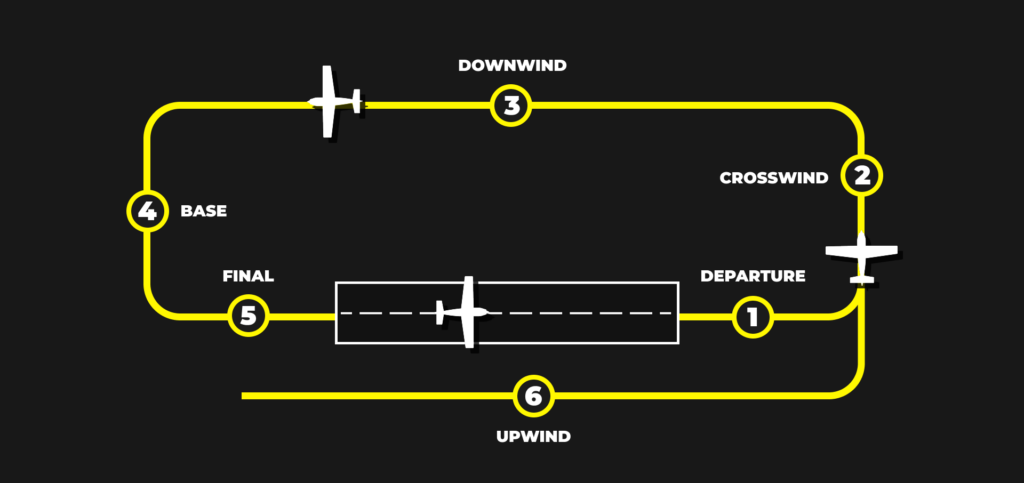When pilots take off and land at airports, they follow a standardized traffic pattern to ensure safety and organization in the airspace. Whether at a towered or non-towered airport, the traffic pattern helps keep aircraft separated and prevents mid-air conflicts. In this guide, we’ll break down the essential components of a traffic pattern, how to fly it correctly, and why it’s crucial for aviation safety.
- What is a Traffic Pattern?
- The 5 Main Legs of the Traffic Pattern
- Left vs. Right Traffic Patterns
- How to Enter the Traffic Pattern
- Communication at Non-Towered Airports
- Segmented Circles & Wind Indicators
- ATC Instructions at Towered Airports
- Noise Abatement & Special Procedures
- Abschließende Gedanken
What is a Traffic Pattern?
A traffic pattern is a rectangular flight path that aircraft follow when approaching or departing an airport. This structured path allows for smooth and predictable movements, reducing risks, especially at busy airfields. Most traffic patterns are flown at 1,000 feet above airport elevation.
The 5 Main Legs of the Traffic Pattern
Each traffic pattern consists of five primary legs, which form a rectangle around the runway:
- Departure Leg – This is the initial climb after takeoff, aligned with the runway heading.
- Crosswind Leg – A 90-degree turn away from the runway, transitioning from departure.
- Downwind Leg – A straight and level flight parallel to the runway but in the opposite direction of landing.
- Base Leg – Another 90-degree turn towards the approach path, leading to final.
- Final Leg – The last segment where the aircraft aligns with the runway and descends for landing.
Bonus: The Upwind Leg
In addition to these five legs, there is also the upwind leg, which runs parallel to the runway on the opposite side of the downwind leg. Pilots use this leg when they need to go around or adjust their spacing in the pattern.

Left vs. Right Traffic Patterns
The standard traffic pattern follows left turns at every leg unless otherwise indicated. Some airports, however, have right-hand traffic patterns due to obstacles, noise abatement, or terrain considerations. These right-hand patterns are marked on aeronautical charts and segmented circles at the airport.
How to Enter the Traffic Pattern
To ensure smooth integration into the flow of air traffic, pilots should enter the traffic pattern at a 45-degree angle to the downwind leg. This approach provides good visibility and helps pilots spot other aircraft in the pattern.

Communication at Non-Towered Airports
At non-towered airports, pilots must announce their position using radio calls to maintain situational awareness. A typical call might be:
“[Airport Name] Traffic, Cessna 172 on left base for Runway 18.”
These calls help other pilots in the pattern anticipate movements and avoid conflicts.
Segmented Circles & Wind Indicators
To assist pilots in identifying the correct traffic pattern, segmented circles are installed at many airports. These visual indicators show the correct flow of traffic for each runway. Additionally, pilots rely on wind socks, tetrahedrons, or wind tees to determine wind direction and speed, which influence their approach and landing decisions.
ATC Instructions at Towered Airports
At controlled airports, Air Traffic Control (ATC) manages the traffic pattern. ATC may instruct pilots to:
- Fly a straight-in approach instead of entering the full pattern.
- Enter the pattern at a different leg, such as base or final.
- Follow specific sequencing for spacing and separation from other aircraft.
Noise Abatement & Special Procedures
Many airports have noise abatement procedures to minimize disturbances to nearby residential areas. These may include:
- Restricted flight training hours (e.g., no touch-and-go landings at night).
- Adjusted traffic patterns to avoid flying over noise-sensitive zones.
- Informational signs near runways and FBOs to guide pilots on local procedures.
Abschließende Gedanken
Understanding and following the traffic pattern is essential for safe and efficient operations at any airport. Whether flying in a towered or non-towered environment, adhering to standard procedures ensures better coordination with other pilots and reduces risks. By mastering traffic patterns, you can enhance your aviation skills and become a more confident pilot.